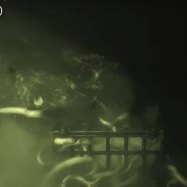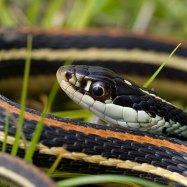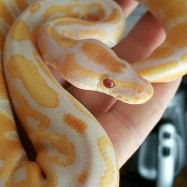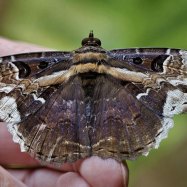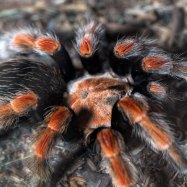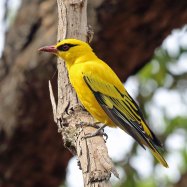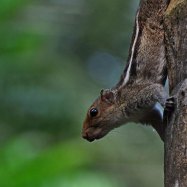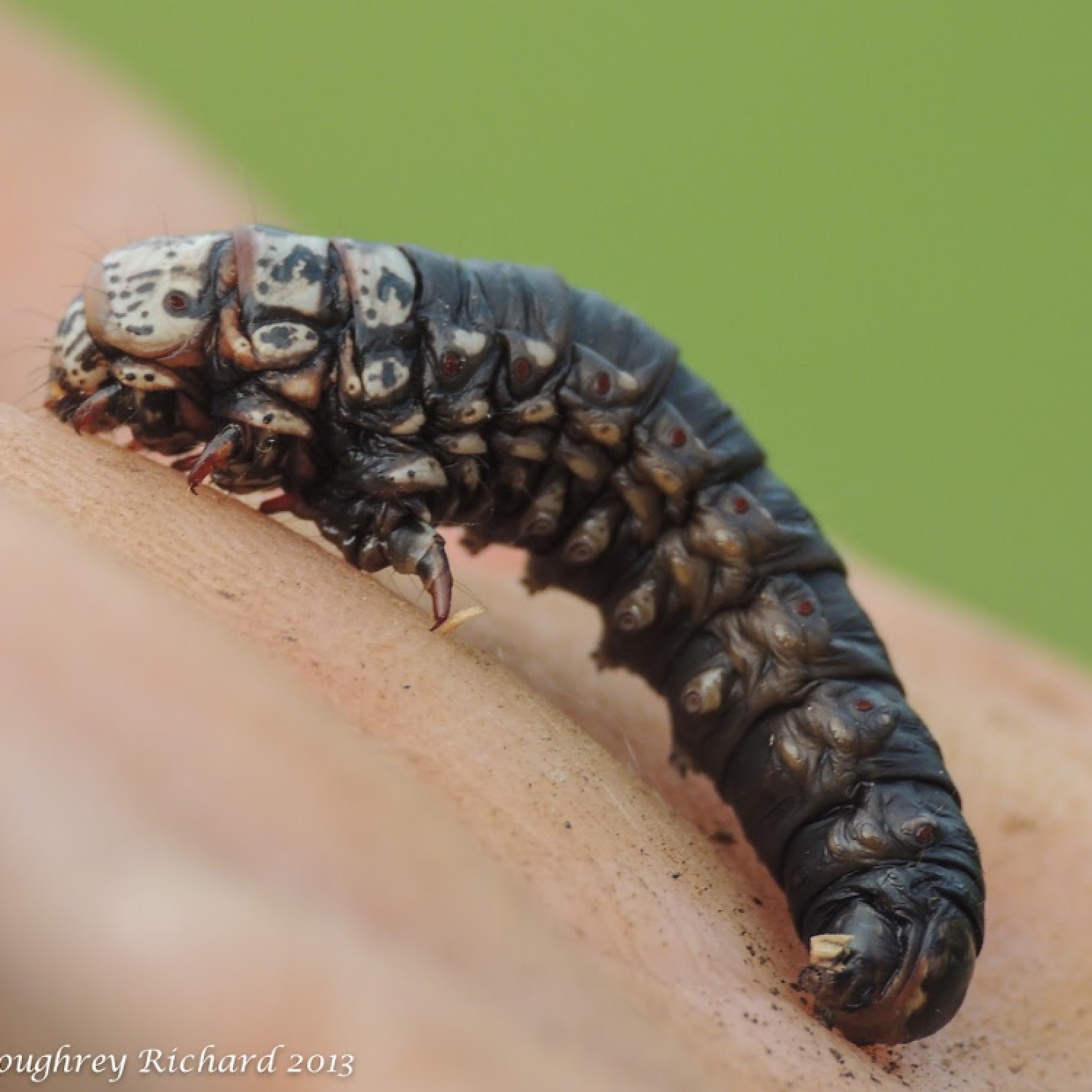
Bagworm Moth Caterpillar
Bagworm moth caterpillars typically grow up to 1 inch in length.
Bagworm moth caterpillars are fascinating creatures belonging to the family Psychidae. These small insects have a unique cylindrical body shape and are often found to be around 1 inch in length. They are commonly found in various regions, making their homes in a bag-like structure made from silk and plant material. These cute critters may be small but play an important role in maintaining the balance of our natural ecosystems.
Animal Details Summary:
Common Name: Bagworm Moth Caterpillar
Kingdom: Animalia
Habitat: Bagworm moth caterpillars are found in various habitats including forests, gardens, and urban areas.
Tiny Builders: The Fascinating World of Bagworm Moth Caterpillars
In the insect world, there are many creatures that captivate our attention with their unique behavior and appearances. However, one particular species stands out with its incredible building skills and survival tactics – the Bagworm Moth Caterpillar.As the name suggests, the Bagworm Moth Caterpillar belongs to the family Psychidae, which is a part of the larger order of Lepidoptera – the butterfly and moth family. These tiny caterpillars can be found in different habitats, including forests, gardens, and even urban areas, making them a common sight for those who keep a keen eye on the natural world Bagworm Moth Caterpillar.
Although their scientific name may not sound very appealing, the Bagworm Moth Caterpillars are truly fascinating creatures once you get to know them. So, let's dive into the world of these tiny builders and discover what makes them so unique.
The Life of a Bagworm Moth Caterpillar
The Bagworm Moth Caterpillar starts its life as an egg laid by an adult female moth. Once the egg hatches, the tiny caterpillar begins its journey by searching for a suitable place to call home. In contrast to their name, the Bagworm Moth Caterpillars do not build bags right away. They start off by creating a small silk case, also known as the "bag".The caterpillar attaches this bag to a branch or a leaf using silk and bits of plant materials. As it grows, the caterpillar adds more material to its bag, making it stronger and more protective. The bag also serves as camouflage for the caterpillar, allowing it to blend in with the surroundings and escape predators Bee.
A Tiny Architect
One of the most remarkable features of the Bagworm Moth Caterpillar is its building skills. These tiny creatures are known for their ability to construct intricate and highly durable bags. But how do they do it?The secret lies in the caterpillar's silk glands, which produce a strong and adhesive silk material. They use this silk to attach pieces of leaves, twigs, and other plants to create their bag. The caterpillar also uses its mouth to cut and shape the material according to its needs. Each bag is unique, and it serves as a home, a shelter, and a protective covering for the caterpillar.
A Taste for Plants
Like their butterfly and moth relatives, the Bagworm Moth Caterpillar is an herbivore, meaning they feed on plants. However, unlike other caterpillars that crawl around aimlessly, these tiny architects prefer to stay inside their bags while feeding. They use their powerful jaws to chew on leaves and other plant materials, making sure to always keep their bag close for protection.During their feeding frenzy, the caterpillars can cause severe damage to plants, especially trees. Their silk bags provide them with a comfortable and safe shelter, allowing them to stay in one place and continue feeding until they reach their full size.
A Colorful World of Bagworm Moth Caterpillars
As mentioned earlier, the coloration of Bagworm Moth Caterpillars can vary depending on the materials they use to build their bags. They can be green, brown, or gray, and their bags may have different patterns and textures, making them blend in with their surroundings. This color-changing ability serves as another survival tactic for the caterpillar, allowing them to hide from potential predators.Moreover, the bags themselves are incredibly durable, providing protection against harsh weather conditions and other external threats. They also serve as shelter from predators such as birds and small mammals.
The Next Phase: Metamorphosis
Like all members of the Lepidoptera family, the Bagworm Moth Caterpillars go through a remarkable transformation known as metamorphosis. After reaching their full size, the caterpillar attaches its bag to a branch or a leaf and starts its journey towards becoming an adult moth.Inside the bag, the caterpillar spins a silk cocoon that will provide the ideal environment for its transformation. After a few weeks, the caterpillar undergoes a complex process where it sheds its skin and transforms into a pupa or chrysalis. From the chrysalis, an adult moth emerges, ready to take on the world.
Bagworm Moth Caterpillars Around the World
The Bagworm Moth Caterpillar can be found in various parts of the world, including North America, Europe, Asia, and Australia. They thrive in different habitats, from forests to urban areas, as long as they have enough plants to feed on and materials to build their bags.In most areas, they are considered a nuisance due to their destructive feeding habits, especially in agriculture and forestry. However, they play a vital role in the ecosystem, contributing to the decomposition of plant material and providing a food source for other animals.
In Conclusion
The Bagworm Moth Caterpillar may be small and often overlooked, but its building skills and survival tactics make it a remarkable creature. From constructing intricate bags to changing colors, these tiny architects have a lot to teach us about adaptation and resilience.So next time you see a little bag hanging from a tree, take a closer look – you might just spot a Bagworm Moth Caterpillar and all its incredible building techniques.

Bagworm Moth Caterpillar
Animal Details Bagworm Moth Caterpillar - Scientific Name: Psychidae
- Category: Animals B
- Scientific Name: Psychidae
- Common Name: Bagworm Moth Caterpillar
- Kingdom: Animalia
- Phylum: Arthropoda
- Class: Insecta
- Order: Lepidoptera
- Family: Psychidae
- Habitat: Bagworm moth caterpillars are found in various habitats including forests, gardens, and urban areas.
- Feeding Method: Bagworm moth caterpillars are herbivores and feed on a variety of plants. They construct a protective case made of silk and plant materials, which they carry around with them as they feed.
- Geographical Distribution: Bagworm moth caterpillars are found in North America, Europe, Asia, and Australia.
- Country of Origin:
- Location:
- Animal Coloration: The coloration of bagworm moth caterpillars depends on the materials they use to construct their protective case. They can be green, brown, or gray.
- Body Shape: Bagworm moth caterpillars have a cylindrical body shape with short legs.
- Length: Bagworm moth caterpillars typically grow up to 1 inch in length.

Bagworm Moth Caterpillar
- Adult Size:
- Average Lifespan: The lifespan of a bagworm moth caterpillar can range from several weeks to several months, depending on environmental conditions and species.
- Reproduction: Bagworm moth caterpillars go through a complete metamorphosis, which includes egg, larva, pupa, and adult stages. The female lays eggs inside her protective case, and the larvae hatch and develop inside the case until they are ready to pupate.
- Reproductive Behavior:
- Sound or Call:
- Migration Pattern:
- Social Groups:
- Behavior:
- Threats: Bagworm moth caterpillars can become pests in gardens and urban areas, as they can defoliate trees and shrubs. They are also susceptible to predation by birds and other insects.
- Conservation Status:
- Impact on Ecosystem:
- Human Use:
- Distinctive Features: The most distinctive feature of bagworm moth caterpillars is their protective case, which they construct using silk and plant materials. This case helps them camouflage and protect themselves from predators.
- Interesting Facts: 1. Bagworm moth caterpillars are often mistaken for small twigs or pinecones because of their protective case. 2. The adult bagworm moths are often wingless and have reduced mouthparts, as their sole purpose is to reproduce. 3. Bagworm moth caterpillars are considered pests in agriculture and horticulture due to their feeding habits.
- Predator: Bagworm moth caterpillars are preyed upon by birds, spiders, wasps, and other insects.
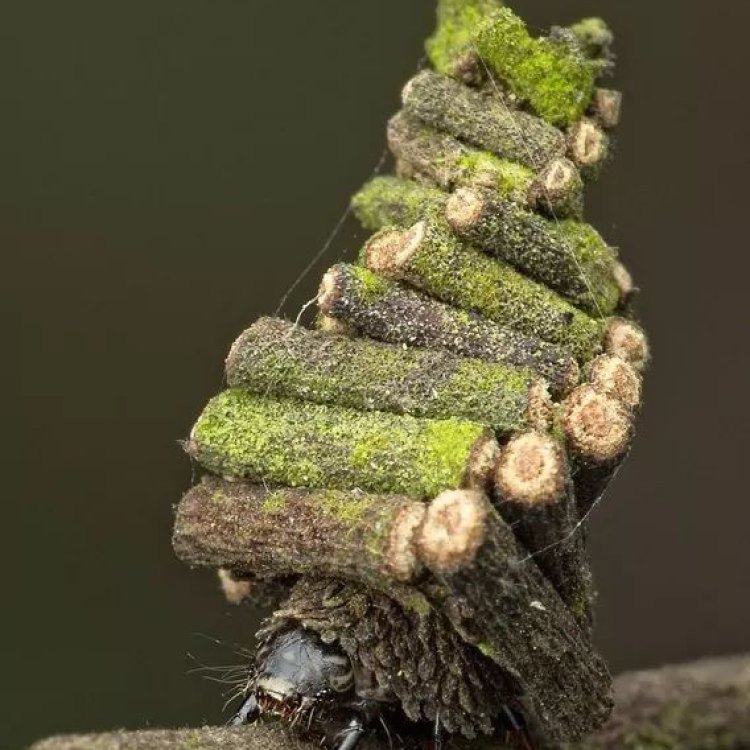
Psychidae
The Secret Life of the Bagworm Moth Caterpillar: Master of Disguise and Pillar of the Ecosystem
Have you ever come across a small twig or pinecone that seemed to be moving? You might have thought it was an illusion, but it could have been a bagworm moth caterpillar. These remarkable creatures are experts at disguise and can often be found blending seamlessly into their environment.But don't be fooled by their camouflaged appearance; the bagworm moth caterpillar has an intriguing life cycle and holds significant importance in the ecosystem. In this article, we will explore the unique features and behaviors of this elusive creature PeaceOfAnimals.Com.
Adult Size and Average Lifespan
Bagworm moth caterpillars may seem small and insignificant, but they play a crucial role in the ecosystem. As larvae, they are typically around 1cm long, but their size can vary depending on their species and environment. As adults, the bagworm moth's average wingspan can range from 25-40 mm.In terms of lifespan, bagworm moth caterpillars can live for several weeks to several months, depending on their species and environmental conditions. However, their adult life is much shorter as their sole purpose is to reproduce.
Reproduction and Reproductive Behavior
Like many insects, bagworm moth caterpillars go through a complete metamorphosis, which includes four distinct stages: egg, larva, pupa, and adult. The female bagworm moth lays her eggs inside her protective case, which she has constructed using silk and plant materials.The larvae hatch from the eggs and begin to feed and grow inside the case. As they develop, they continuously add more material to their case, making it bigger and more complex Belted Kingfisher. The case serves as their home and a means of protection from predators.
When they are ready to pupate, the larvae will attach their case to a solid surface and undergo metamorphosis inside. Once they emerge as adults, they will mate and repeat the cycle, starting with laying their eggs.
Though their reproductive behavior may seem simple, it is a crucial part of the ecosystem. Bagworm moth caterpillars are responsible for the continuation of their species, and without them, the balance of the ecosystem could potentially be disrupted.
Sounds and Calls
Unlike some insects that make noticeable sounds, bagworm moth caterpillars do not produce any significant sounds or calls. This behavior further adds to their ability to stay hidden and undetected in their environment.No Migration, But Strong Social Bonds
Bagworm moth caterpillars do not take part in any migration patterns. Their larval stage is spent inside their protective case in their chosen habitat. However, they do showcase strong social bonds with their siblings while inside the case.Bagworm moth caterpillars may live in clusters in one tree or shrub and often feed together. This behavior increases their chances of survival and also highlights their social nature.
Behavior and Unique Defense Mechanisms
One of the most unique behaviors of the bagworm moth caterpillar is their ability to construct their own protective case. This case is made of silk and plant material, mainly from the tree or shrub they are feeding on. They attach the case to their body and use it as a shelter and camouflage from predators.But their defense mechanisms do not stop there. Bagworm moth caterpillars also have a strong grip and will cling on to their protective case tightly if they sense danger. This behavior makes it difficult for predators to attack them or remove them from their case.
When they sense a threat, they will also sway their body, mimicking the movement of a twig or branch, further enhancing their camouflage.
Threats and Conservation Status
Bagworm moth caterpillars may seem like they have a strong defense system, but they do have some predators. Birds, spiders, wasps, and other insects are known to prey on these caterpillars. Their protective case may help, but it is not entirely foolproof.Another threat to bagworm moth caterpillars is their potential to become pests in gardens and urban areas. They are voracious eaters and can defoliate trees and shrubs, causing significant damage to plants.
While they may seem like pests to humans, bagworm moth caterpillars are an essential part of the ecosystem. They serve as a food source for birds and other insects and play a role in nutrient cycling.
Their conservation status is not specifically known, but their populations are thought to be declining due to habitat destruction and pesticide use. As with many creatures, their survival is dependent on the protection of their habitat and overall ecosystem.
Impact on the Ecosystem
Bagworm moth caterpillars may seem insignificant and easily overlooked, but their impact on the ecosystem is significant. They play a part in nutrient cycling, serve as food for other creatures, and help maintain the balance of their habitat.Without them, the ecosystem could potentially suffer, leading to a ripple effect that could impact other plants and animals.
Human Use and Distinctive Features
Bagworm moth caterpillars do not have many direct uses for humans, except for being a food source for some birds and other insects. However, their unique features have sparked human interest and curiosity.The most distinctive feature of bagworm moth caterpillars is their protective case. The case is essential for their survival and serves as a means of camouflage and protection from predators. It also makes them appear like small twigs or pinecones, adding to their ability to blend into their environment.
Interesting Facts
1. Bagworm moth caterpillars are often mistaken for small twigs or pinecones because of their protective case, further highlighting their impressive camouflage abilities.2. The adult bagworm moths are wingless and have reduced mouthparts, as their sole purpose is to reproduce. This adaptation showcases their single-minded focus on reproducing and continuing their species.
3. Bagworm moth caterpillars are considered pests in agriculture and horticulture due to their feeding habits. However, they serve as a natural form of pest control by preying on various plant species, helping to maintain the balance of their habitat.
Predators
Despite their impressive defense mechanisms, bagworm moth caterpillars do have predators. Birds, spiders, wasps, and other insects feed on these caterpillars, making them a vital food source in the ecosystem.In Conclusion
The bagworm moth caterpillar may not be the most well-known insect, but their unique features, behaviors, and impact on the ecosystem make them a fascinating creature. From their remarkable camouflage abilities to their role in nutrient cycling, these caterpillars have much to teach us about the delicate balance of the natural world. As we continue to learn about these creatures, it is essential to also emphasize the importance of their conservation and protection in maintaining a healthy ecosystem for all species to thrive.
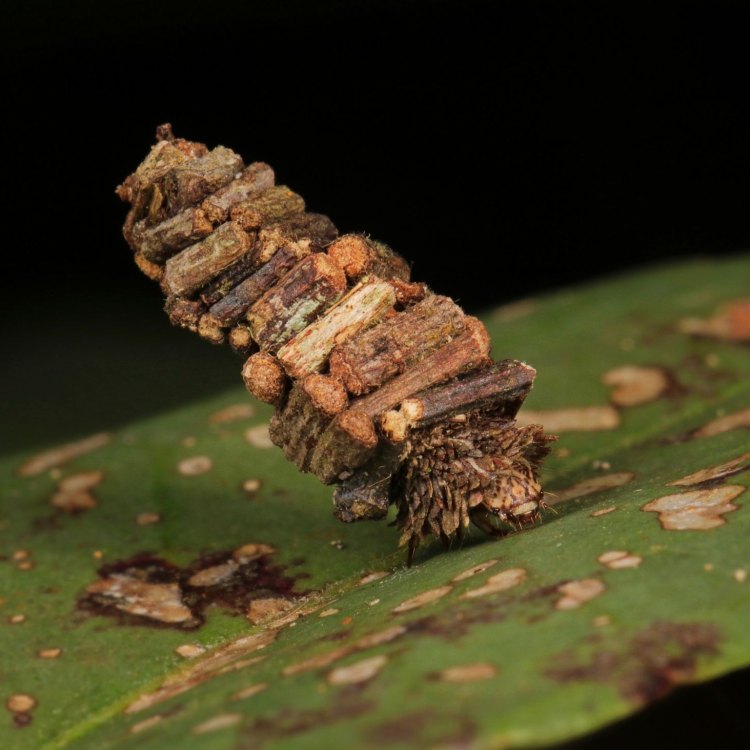
Tiny Builders: The Fascinating World of Bagworm Moth Caterpillars
Disclaimer: The content provided is for informational purposes only. We cannot guarantee the accuracy of the information on this page 100%. All information provided here may change without prior notice.


